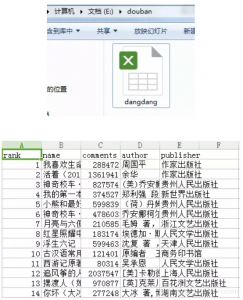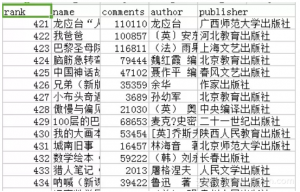摘要: 简介 asyncio可以实现单线程并发io操作,是python中常用的异步处理模块。关于asyncio模块的介绍,笔者会在后续的文章中加以介绍,本文将会讲述一个基于asyncio实现的http框架——aiohttp,它可以帮助我们异步地实现http请求,从而使得我们的程序效率大大提高。
简介
asyncio可以实现单线程并发io操作,是python中常用的异步处理模块。关于asyncio模块的介绍,笔者会在后续的文章中加以介绍,本文将会讲述一个基于asyncio实现的http框架——aiohttp,它可以帮助我们异步地实现http请求,从而使得我们的程序效率大大提高。
本文将会介绍aiohttp在爬虫中的一个简单应用。
在原来的项目中,我们是利用python的爬虫框架scrapy来爬取当当网图书畅销榜的图书信息的。在本文中,笔者将会以两种方式来制作爬虫,比较同步爬虫与异步爬虫(利用aiohttp实现)的效率,展示aiohttp在爬虫方面的优势。
同步爬虫
首先,我们先来看看用一般的方法实现的爬虫,即同步方法,完整的python代码如下:
'''
同步方式爬取当当畅销书的图书信息
'''
import time
import requests
import pandas as pd
from bs4 import beautifulsoup
# table表格用于储存书本信息
table = []
# 处理网页
def download(url):
html = requests.get(url).text
# 利用beautifulsoup将获取到的文本解析成html
soup = beautifulsoup(html, "lxml")
# 获取网页中的畅销书信息
book_list = soup.find('ul', class_="bang_list clearfix bang_list_mode")('li')
for book in book_list:
info = book.find_all('div')
# 获取每本畅销书的排名,名称,评论数,作者,出版社
rank = info[0].text[0:-1]
name = info[2].text
comments = info[3].text.split('条')[0]
author = info[4].text
date_and_publisher = info[5].text.split()
publisher = date_and_publisher[1] if len(date_and_publisher) >= 2 else ''
# 将每本畅销书的上述信息加入到table中
table.append([rank, name, comments, author, publisher])
# 全部网页
urls = ['http://bang.dangdang.com/books/bestsellers/01.00.00.00.00.00-recent7-0-0-1-%d' % i for i in range(1, 26)]
# 统计该爬虫的消耗时间
print('#' * 50)
t1 = time.time() # 开始时间
for url in urls:
download(url)
# 将table转化为pandas中的dataframe并保存为csv格式的文件
df = pd.dataframe(table, columns=['rank', 'name', 'comments', 'author', 'publisher'])
df.to_csv('e://douban/dangdang.csv', index=false)
t2 = time.time() # 结束时间
print('使用一般方法,总共耗时:%s' % (t2 - t1))
print('#' * 50)
输出结果如下:
##################################################
使用一般方法,总共耗时:23.522345542907715
##################################################
程序运行了23.5秒,爬取了500本书的信息,效率还是可以的。我们前往目录中查看文件,如下:

异步爬虫
接下来我们看看用aiohttp制作的异步爬虫的效率,完整的源代码如下:
'''
异步方式爬取当当畅销书的图书信息
'''
import time
import aiohttp
import asyncio
import pandas as pd
from bs4 import beautifulsoup
# table表格用于储存书本信息
table = []
# 获取网页(文本信息)
async def fetch(session, url):
async with session.get(url) as response:
return await response.text(encoding='gb18030')
# 解析网页
async def parser(html):
# 利用beautifulsoup将获取到的文本解析成html
soup = beautifulsoup(html, "lxml")
# 获取网页中的畅销书信息
book_list = soup.find('ul', class_="bang_list clearfix bang_list_mode")('li')
for book in book_list:
info = book.find_all('div')
# 获取每本畅销书的排名,名称,评论数,作者,出版社
rank = info[0].text[0:-1]
name = info[2].text
comments = info[3].text.split('条')[0]
author = info[4].text
date_and_publisher = info[5].text.split()
publisher = date_and_publisher[1] if len(date_and_publisher) >=2 else ''
# 将每本畅销书的上述信息加入到table中
table.append([rank,name,comments,author,publisher])
# 处理网页
async def download(url):
async with aiohttp.clientsession() as session:
html = await fetch(session, url)
await parser(html)
# 全部网页
urls = ['http://bang.dangdang.com/books/bestsellers/01.00.00.00.00.00-recent7-0-0-1-%d'%i for i in range(1,26)]
# 统计该爬虫的消耗时间
print('#' * 50)
t1 = time.time() # 开始时间
# 利用asyncio模块进行异步io处理
loop = asyncio.get_event_loop()
tasks = [asyncio.ensure_future(download(url)) for url in urls]
tasks = asyncio.gather(*tasks)
loop.run_until_complete(tasks)
# 将table转化为pandas中的dataframe并保存为csv格式的文件
df = pd.dataframe(table, columns=['rank','name','comments','author','publisher'])
df.to_csv('e://douban/dangdang.csv',index=false)
t2 = time.time() # 结束时间
print('使用aiohttp,总共耗时:%s' % (t2 - t1))
print('#' * 50)
我们可以看到,这个爬虫与原先的一般方法的爬虫的思路和处理方法基本一致,只是在处理http请求时使用了aiohttp模块以及在解析网页时函数变成了协程(coroutine),再利用aysncio进行并发处理,这样无疑能够提升爬虫的效率。它的运行结果如下:
##################################################
使用aiohttp,总共耗时:2.405137538909912
##################################################
2.4秒,如此神奇!!!再来看看文件的内容:

总结
综上可以看出,利用同步方法和异步方法制作的爬虫的效率相差很大,因此,我们在实际制作爬虫的过程中,也不妨可以考虑异步爬虫,多多利用异步模块,如aysncio, aiohttp。另外,aiohttp只支持3.5.3以后的python版本。
原文链接:https://yq.aliyun.com/articles/673946